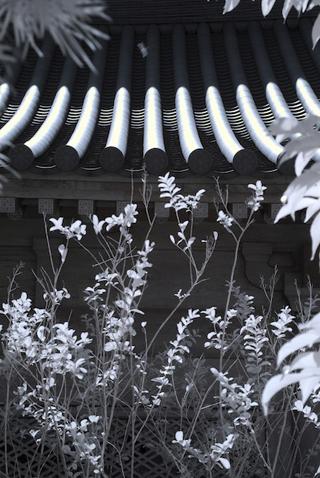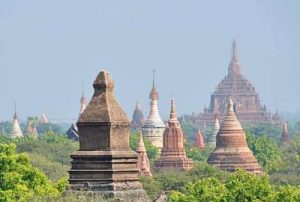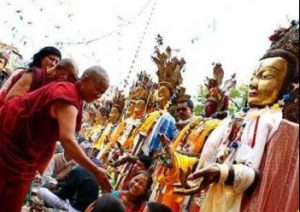A tremendous portion of Chinese Buddhism’s rich inheritance is drawn from two traditions. On the one hand we have the deeply devotional Pure Land, where the Other-Power of Amit?bha Buddha is invoked through Buddha-recitation (nienfo) for rebirth into the “Western Paradise”, known as Sukh?vati in Sanskrit. On the other hand we have Ch’an, a powerful pedagogy of non-dualism and deconstruction that ruthlessly cuts away all conventional prudence through intense meditation and perplexing gong an (more famously known as koan in the Japanese).
Ironically, although both traditions dismiss dualism, together they could be said to represent the two faces of Chinese Buddhism. Devout, but sharp and no-nonsense. Respectful of spiritual authority… yet endearingly ironic and humorous. Calm detachment fused with a bodhisattva’s passion to help, to heal, and to love.
In other words, if you want to learn about Chinese Buddhism, study Pure Land and Ch’an. But how did these two traditions come to represent this vast political, philosophical, cultural, and spiritual phenomenon called “Chinese Buddhism”?
Buddhism trickled into China as early as the Han Dynasty (206 BCE – 220 CE) and was initially used by the Emperor and other nobles as one of their many religious practices for imperial legitimization and security in the afterlife. But it was during the Tang Dynasty (618 – 907 CE) that Chinese Buddhism reached not just one, but several milestones. It was in the Tang period that fully Sinicized schools of Buddhism emerged – the four most important were Tiantai, Huayan, Ch’an, and Pure Land. These schools all traced their origin to the most important figure of all – ??kyamuni Buddha – but otherwise, they had no antecedents in Buddhism’s land of origin. The rise of Buddhism under the Tang was synonymous with the rise of indigenous Buddhist traditions. In contrast to the esteem previously held for monks and teachings from the west, the Islamic conquests of Central Asia and the Tantric takeover of India prompted the Tang to reorient itself as the new central Buddhist realm, at the epicenter of the medieval Asian order.
It was against the Tang backdrop that Ch’an and Pure Land emerged and came to the forefront as popular schools of practice.
Ch’an had a long history before the Five Houses (see more detail on this below). The story of the Buddha holding up a flower and Ka?yapa’s instant intuition of the teaching forms the timeless, mythic foundation for the Zen spirit. Indeed, the Tang Dynasty was popularly known as the Golden Age for Ch’an because the patriarchs Daoxin, Hongren, Shenxiu, Huineng, and Shenhui all lived during the empire’s early period. The fortunes of all Chinese Buddhist schools grew in this period thanks to the explosion of intellectual productivity that came from its monks, thinkers, and translators. The Tang Dynasty’s imperial patronage also made a big difference.
Unfortunately, a horrific portion of these schools were decimated when Tang Emperor Wuzong carried out a series of mass persecutions from 841 to 846. The persecutions consisted of the mass confiscation of monasteries’ money, the closing of most temples in the empire, and the forced defrocking and massacre of thousands of monks and nuns. Originally intended as a short-term strategy to snatch back the tax-exempt wealth of Buddhist institutions, it became a catastrophic mistake that set off the decline of high Tang culture. Even though Emperor Wuzong’s successor immediately reversed the policy, the damage was done. Not only did Buddhism lose its political power (at its height, a monk named Fazang was the right-hand man for Empress Wu of the intermittent Zhou Dynasty), many schools also lost their teachers and students to civilian life. Along with this fatal loss of people power went their institutional relevance. From thereon, schools like Tiantai and Huayan only wielded intellectual authority, and today they are still valued as influential philosophical influences on Ch’an and Pure Land.
Before Wuzong’s persecutions, Buddhism flourished in an age of imperial glory and patronage. Yet it was Pure Land and Ch’an that emerged from the ashes of the old Buddhist order, revitalized and representing the popular interests of Chinese devotees. We can’t be completely sure why. Sometimes history is simply well disposed to the fortunate and tenacious. Metropolitan Ch’an monasteries had also suffered greatly from Wuzong’s persecutions. But “rural” Ch’an, which was self-sufficient with its farms, and scattered about the countryside, was more or less safe from the political upheavals of the Tang. It survived and split into the “Five Houses”. These schools – the Guiyang, Linji, Caodong, Yunmen, and Fayan Houses – would forge their own paths in the aftermath of the Great Persecution and an irrevocably declining Tang.
Of these five schools, Linji remains the most influential in China today. Founded by Linji Yixuan, the school was famous for urging students to break through conceptual thinking through conventionally bizarre methods like striking and shouting. In contrast, the Guiyang School was renowned for an emphasis on meditation and contemplation of gong an, metaphors, and poetic and artistic images. The Fayan School united practice and doctrine through a combination of strict asceticism and a rigorous study of Ch’an doctrine and commentaries on the tradition. The Yunmen School also expressed itself through eloquent gong an. Much of modern Ch’an incorporates this spectrum of practices because it was during the Tang’s great successor, the Song Dynasty period, that the Linji School absorbed the methods of the others. By this time the Linji School had also made inroads into Japan, during the contemporaneous Kamakura era.
The Caodong School was founded by Dongshan Liangjie, and it gained international fame after export to Japan in 1227 by Dogen Zenji, where it evolved into the renowned Soto Zen tradition. The Yunmen School was also able to carry on through the modern Ch’an Master Hsu Yun, who managed to propagate the tradition in the United States. Brought together, Linji or Rinzai’s unconventional teaching techniques and Soto Zen’s shikantaza philosophy (detached meditation on all inner thoughts until there is “no thought”) still hold a compelling grip over our ideas of what it means to be a Ch’an or Zen Buddhist.
For their part, the heirs to the official founder of Chinese Pure Land, Huiyuan, were unlike the more cerebral masters of Huayan and Tiantai Schools. Like their mysterious Indian and Central Asian forebears, they were more concerned with spreading the practice of Buddha-invocation than debating scriptural hermeneutics (although there were plenty of exegetically informed Pure Land masters). Perhaps the strong following among the laity was why, as a popular movement, it could sustain its long-term vitality after Wuzong’s persecutions. The Chinese masters of Pure Land have, to this day, preached the tradition as an all-embracing “easy path” suitable for all beings, although any practitioner will tell you that nienfo recitations can be just as arduous and demanding as Ch’an meditation.
Doctrinally, there are plenty of things that separate Ch’an from Pure Land. Traditionally, the severe discipline of Ch’an has been tied to the idea of self-reliance, whilst Pure Land’s devotion to Amit?bha Buddha invokes a higher power that is not only external to us but also dwelling deep within our own Buddha Nature. But perhaps in many ways they are not so different: after all, they both emphasize practice over scholasticism, a transmission of masters from teacher to disciple, the possibility of enlightenment in this very life, and the freedom to understand religious experience in one’s own, personal way.
The complex history and legacy of the two traditions have contributed to their longevity through the ages, and earned them the well-deserved roles of Chinese Buddhism’s greatest representatives. Indeed, it was probably the Sixth Patriarch of Ch’an, Huineng (638 – 713), who gave voice to a “sacred cooperation” between Ch’an and Pure Land when he said:
“If you see the true nature in all your thoughts and constantly dwell in sincerity, you will reach the West and see Amit?bha Buddha in an instant.”
(Platform S?tra, Chapter III)







